Related Research Articles
OSU, Osu, or osu can stand for:
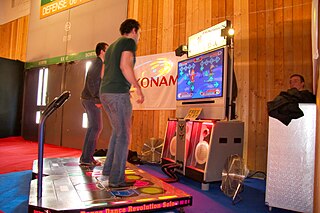
Rhythm game or rhythm action is a genre of music-themed action video game that challenges a player's sense of rhythm. Games in the genre typically focus on dance or the simulated performance of musical instruments, and require players to press buttons in a sequence dictated on the screen. Many rhythm games include multiplayer modes in which players compete for the highest score or cooperate as a simulated musical ensemble. Rhythm games often feature novel game controllers shaped like musical instruments such as guitars and drums to match notes while playing songs. Certain dance-based games require the player to physically dance on a mat, with pressure-sensitive pads acting as the input device.

An ōendan (応援団), literally "cheering squad" or "cheering section", is a Japanese sports rallying team similar in purpose to a cheerleading squad in the United States, but relies more on making a lot of noise with taiko drums, blowing horns and other items, waving flags and banners, and yelling through plastic megaphones in support of their sports team than on acrobatic moves. In addition to cheering for their own teams, ōendan have been known to lead fans in cheers which tease and taunt the other team and its fans. This is usually done in the spirit of good competition, but occasional fights have broken out if the taunting gets too heated. Smaller ōendan are sometimes called ōenbu.
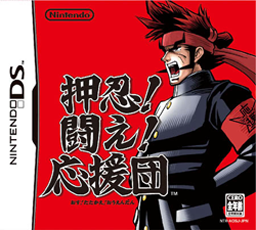
Osu! Tatakae! Ouendan, or Ouendan, is a rhythm video game developed by iNiS and published by Nintendo for the Nintendo DS handheld game console in 2005, for release only in Japan. Ouendan stars a cheer squad rhythmically cheering for various troubled people, presented in-game in the style of a manga comic. In each stage, players use the DS touchscreen to tap specifically marked spots that appear in rhythm to various Japanese pop songs, scoring points for accurate timing and avoiding a poor performance which can cause the stage to end prematurely. Though never released in Western markets, it was a popular import to these regions, leading to the development of the Westernized spiritual sequel Elite Beat Agents, as well as a direct Japanese sequel Moero! Nekketsu Rhythm Damashii Osu! Tatakae! Ouendan 2.
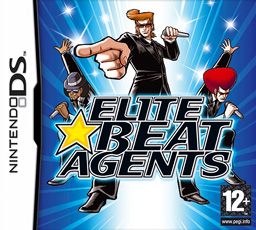
Elite Beat Agents is a rhythm video game developed by iNiS and published by Nintendo for the Nintendo DS. It was released in North America, Europe and South Korea. As the second of three rhythm games developed by iNiS specifically for the DS, it is the spiritual sequel and international counterpart to Osu! Tatakae! Ouendan, a Japanese rhythm game released in 2005, sharing many common elements with it.
"Go My Way" was the fourteenth Japanese single release from Hitomi Yaida. It is also the first single released from the album It's a New Day.
LIONA Interactive (株式会社LIONA) is a Japanese video game developer that specializes in rhythm games.
Kotaro Umeji is a Japanese graphic designer. He has shaped the image of U-1 and other characters from the video game Gitaroo Man for the PlayStation 2 video game console and Gitaroo Man Lives! for the PlayStation Portable video game console, and the characters and art found in Osu! Tatakae! Ouendan and Elite Beat Agents both for the Nintendo DS video game console.

"Ready Steady Go" is the twenty-third single by L'Arc-en-Ciel, released on February 4, 2004; it reached number 1 on the Oricon chart. The four alternate versions on the single omit each titular band member's contributions; for instance, the "Hydeless Version" features none of hyde's vocals, while the "Yukihiroless Version" has no percussion whatsoever.
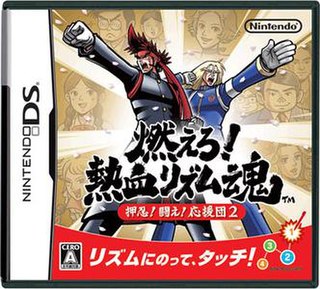
Moero! Nekketsu Rhythm Damashii: Osu! Tatakae! Ouendan 2 is a rhythm video game developed by iNiS and published by Nintendo for the Nintendo DS handheld video game console. It is the third of three rhythm games developed by iNiS for the DS, and is the sequel to Osu! Tatakae! Ouendan while incorporating many of the improvements in gameplay made in its international counterpart, Elite Beat Agents. The game has 4-player wireless play, supports the Nintendo DS Rumble Pak accessory, and was released in Japan on May 17, 2007.
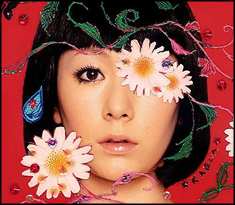
"RIRURA RIRUHA [リルラ リルハ]" is the third single by Japanese pop singer Kaela Kimura, and the first from her album Circle. Released March 30, 2005, it peaked at number three on the Japan Oricon singles chart, Kimura's highest charting single to date. By the end of 2005, Real Life Real Heart had sold 117,299 copies.
"Pop Star" is a song by Japanese singer Ken Hirai. The single went on to top the 2005 Oricon Charts and is known for its remarkable music video, featuring Ken in seven different personas, including a raccoon and his own manager. The Video also helped Hirai break into the US and Canadian Markets where stations would play the video despite the fact that it was in Japanese. The song was featured in the Nintendo DS game, Moero! Nekketsu Rhythm Damashii Osu! Tatakae! Ouendan 2, as well as on Taiko No Tatsujin 8 and Taiko No Tatsujin Portable 2 for the PSP. It is also a track in the Konami's Jubeat Ripples series. Its latest appearance is in the Namco game Happy Dance Collection for the Nintendo Wii. The song was also featured in the Japanese drama Kiken na Aneki starring Ito Misaki.

"Atsuki Kodou no Hate" (熱き鼓動の果て) is the thirty-third single by B'z, released on June 5, 2002. This song is one of B'z many number-one singles in Oricon charts. The song was featured in the arcade drumming game Taiko no Tatsujin and also on the Nintendo DS rhythm game Osu! Tatakae! Ouendan.

Jubeat, stylized as jubeat, is a series of arcade music video games developed by Konami, and is a part of Konami's Bemani line of music video games. The series uses an arrangement of 16 buttons in a 4x4 grid for gameplay, a grid also used for the displaying of cues and part of the user interface.

"Linda Linda" (リンダリンダ) is a single by the Japanese punk rock band The Blue Hearts that was released on May 1, 1987. Lyrics and music were written by Hiroto Kōmoto, the band's lead vocalist, and was arranged by The Blue Hearts. The track reached #38 on the Oricon charts during its release year.

Osu! is a free-to-play rhythm game primarily developed, published, and created by Dean "peppy" Herbert. Inspired by iNiS' rhythm game Osu! Tatakae! Ouendan, it was written in C# on the .NET Framework, and was released for Microsoft Windows on 16 September 2007. The game has throughout the years been ported to macOS, Linux, Android and iOS.
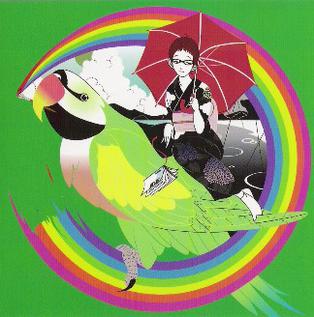
"Loop & Loop" is a song by the Japanese rock band Asian Kung-Fu Generation. It was the second single released from their second full-length studio album, Sol-fa, on May 19, 2004.
Keiichi Yano is a Tokyo-based video game designer and musician responsible for a number of music video game titles including his most famous game, the 2002 cult video game, Gitaroo Man. Yano has been involved in music from a young age and he earned a major in jazz studies at the University of Southern California. He has spent time playing saxophone in Tokyo jazz clubs.

"Monkey Magic" is a song by Japanese rock band Godiego, serving as their 8th single. It is internationally known as the opening theme for the 1978 television series Saiyūki, known in the west as Monkey. The song peaked at #2 on the Oricon Charts and #4 on The Best Ten.

Jewelpet: Magical Dance in Style☆Deco! is a rhythmic music game developed and published by FuRyu. It is the second Jewelpet game for the Nintendo 3DS after Jewelpet Magical Rhythm Yay! and overall the fifth game in the Handheld series. It was released on November 8, 2012, and contains some elements from the fourth anime series, Jewelpet Kira☆Deco!.
References
- ↑ Stern, Zack (8 March 2007). "Creating Osu! Tatakae! Ouendan and its recreation as Elite Beat Agents". engadget . Retrieved 16 November 2021.
- ↑ Kohler, Chris (2006-09-18). "Cheer Squad: Why iNiS Wants to Make You Happier". 1UP.com. p. 5. Archived from the original on 2007-09-27. Retrieved 2006-09-19.
- ↑ Tieryas, Peter (23 June 2019). "Elite Beat Agents Is About Saving The World With Music And Dance". Kotaku . Retrieved 16 November 2021.
- ↑ "IGN.com presents The Best of 2006". IGN.com. 2006. Archived from the original on 2007-01-09. Retrieved 2009-04-26.
- ↑ "Nintendo Power Awards 2006, results". Nintendo Power. 2007-04-03. Archived from the original on 2009-05-10. Retrieved 2009-06-05.
- ↑ Kohler, Chris (7 May 2007). "Elite Beat Agents: Big In Japan". WIRED . Retrieved 23 November 2021.
- ↑ "Osu! Tatakae! Ouendan 2 Release Set, Nintendo Release Schedule Updates". Dengeki Online (in Japanese). MediaWorks. 2007-02-21. Retrieved 2007-02-21.
- ↑ Kohler, Chris (21 June 2007). "Unlock Elite Beat Agents in Ouendan 2". WIRED . Retrieved 3 September 2021.
- ↑ Kohler, Chris (5 December 2006). "NOA Disappointed with Elite Beat Agents Sales, Hints at Sequel". WIRED. Retrieved 16 November 2021.
- ↑ Kohler, Chris (6 June 2007). "Japan Sales: Ouendan 2 Rebounds". WIRED. Retrieved 16 November 2021.
- ↑ Jenkins, David (24 May 2007). "Shining Wind Of Change In Japanese Sales Charts". Game Developer. Retrieved 16 November 2021.
- ↑ "New Video Shows History of Ouendan and Elite Beat Agents". 18 June 2019.
- ↑ Robinson, Nick (May 9, 2016). "Will we ever get an Elite Beat Agents sequel? We asked the creator". Polygon . Retrieved May 10, 2016.
- ↑ DeVries, Jack (1 December 2006). "Happy Feet Review". IGN. Retrieved 6 December 2021.
- ↑ "Michael Jackson's Experience On DS Is A Lot Like Elite Beat Agents". Silconera. 7 November 2010. Retrieved 6 December 2021.
- ↑ 8BitBrian (10 June 2008). "Destructoid review: Looney Tunes: Cartoon Conductor". Destructoid . Retrieved 6 December 2021.
{{cite web}}: CS1 maint: numeric names: authors list (link)